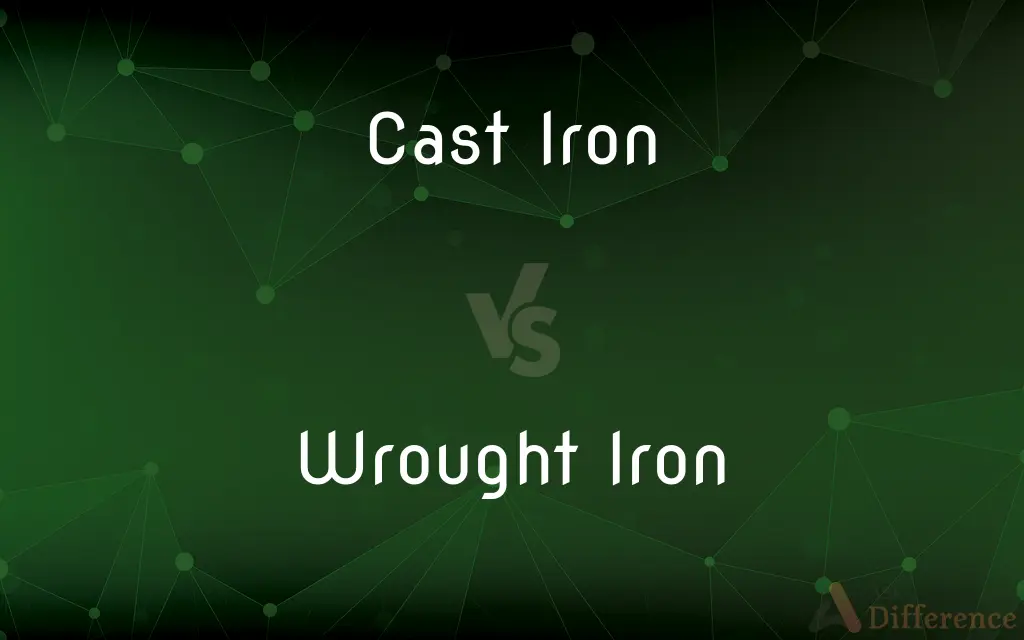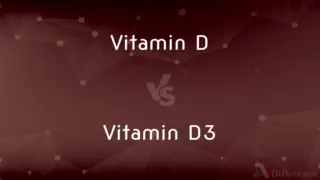Cast Iron vs. Wrought Iron — What's the Difference?
By Tayyaba Rehman — Updated on January 18, 2024
Cast iron is iron that has been melted, poured into a mold, and solidified, while wrought iron is iron with a low carbon content that is tough, malleable, and forged at high temperatures.

Difference Between Cast Iron and Wrought Iron
Table of Contents
ADVERTISEMENT
Key Differences
Cast iron is known for its excellent fluidity, castability, and machinability due to its high carbon content. It becomes hard and brittle when cooled in a mold, which makes it ideal for complex shapes and heavy-duty cookware. Wrought iron, however, is praised for its ductility and toughness, making it suitable for forging into various shapes, such as ornamental ironwork.
In cast iron, the carbon content is higher (typically 2-4%), which contributes to its characteristic hardness. It tends to be brittle and cannot be easily welded or worked at room temperature. Wrought iron, conversely, has a much lower carbon content (below 0.08%) and contains slag that gives it a "grain" resembling wood, often considered aesthetically appealing.
Cast iron is preferred for its ability to retain complex details when cast, a property that stems from its relatively low melting point and fluidity when molten. Wrought iron is worked into various shapes and sizes while hot, typically by rolling or hammering, which enhances its fibrous structure and strength.
The manufacturing process of cast iron involves melting pig iron and pouring it into molds to solidify. Wrought iron is made by heating iron and then working it with tools to purify it and remove excess carbon. The labor-intensive process of making wrought iron makes it more expensive compared to cast iron.
Although both materials are types of iron, their uses often differ due to their inherent properties. Cast iron is commonly used for pipes, machines, and automotive industry components, while wrought iron is favored for decorative and architectural applications due to its workability and attractive finish.
ADVERTISEMENT
Comparison Chart
Carbon Content
High (2-4%)
Low (Below 0.08%)
Characteristics
Brittle and hard
Ductile and tough
Manufacturing Process
Cast from molten iron
Forged at high temperatures
Workability
Poor; breaks under stress
Good; can be welded and reshaped
Common Uses
Cookware, pipes, machinery parts
Gates, fencing, decorative items
Compare with Definitions
Cast Iron
Cast iron is an iron-carbon alloy with a high carbon content that makes it hard and brittle.
The cast iron skillet is perfect for cooking at high temperatures.
Wrought Iron
Wrought iron is a low-carbon iron alloy known for its fibrous appearance and malleability.
Wrought iron fences are both durable and decorative.
Cast Iron
Cast iron can be further classified into white and gray types, depending on its carbon form.
Gray cast iron is used for automotive engine blocks because of its durability.
Wrought Iron
Wrought iron contains slag inclusions that give it a grain-like texture similar to wood.
Wrought iron's unique texture is revealed in the custom-made gate.
Cast Iron
Cast iron is characterized by its excellent fluidity when molten, allowing for intricate castings.
The cast iron bench's ornate design was achieved through precise casting.
Wrought Iron
Wrought iron is worked by hand or machine when hot to produce various shapes and items.
Wrought iron chandeliers are shaped by skilled artisans.
Cast Iron
Cast iron is melted and poured into a mold to set, which is ideal for mass production.
The cast iron gears are essential components in heavy machinery.
Wrought Iron
Wrought iron is often associated with historical ironwork and traditional methods of forging.
The restoration of the old building included replacing damaged wrought iron balustrades.
Cast Iron
Cast iron's high carbon content results in a lower melting point than steel or wrought iron.
Cast iron is often chosen for casting artworks due to its smooth finish.
Wrought Iron
Wrought iron is tough, malleable, and can be welded, which is ideal for artistic blacksmithing.
The blacksmith crafted a beautiful wrought iron railing for the staircase.
Cast Iron
Made of cast iron.
Wrought Iron
Made from wrought iron
Cast Iron
Rigid; inflexible
A cast-iron rule.
Cast Iron
Exceptionally strong or resistant
A cast-iron stomach.
Cast Iron
Alternative spelling of cast iron
Cast Iron
Alternative spelling of cast iron
Cast Iron
Made of cast iron. Hence, Fig.: like cast iron; hardy; unyielding.
Cast Iron
Extremely robust;
An iron constitution
Common Curiosities
What is wrought iron?
Wrought iron is a low-carbon iron alloy, known for its ductility and toughness, used especially for ornamental ironwork.
How is cast iron made?
Cast iron is made by melting pig iron and casting it into molds where it solidifies.
Can cast iron be easily welded?
No, cast iron is brittle and difficult to weld compared to wrought iron.
What is cast iron?
Cast iron is an iron alloy with a high carbon content that is hard and brittle, commonly cast in molds for manufacturing.
How is wrought iron made?
Wrought iron is made by heating and working iron with slag in a forge to reduce the carbon content.
What is the visual difference between cast iron and wrought iron?
Cast iron has a smoother surface, while wrought iron has a wood-like grain texture due to slag inclusions.
Is wrought iron stronger than cast iron?
Wrought iron is more ductile and can withstand tension better, but cast iron is typically harder.
Why is wrought iron less common today?
Wrought iron is less common due to the labor-intensive process and the rise of steel as a preferred material.
Is it easy to shape and resize wrought iron?
Yes, wrought iron can be easily reshaped and welded, especially when heated.
What are the main uses of cast iron?
Cast iron is often used for cookware, pipes, and heavy machinery parts.
Is wrought iron more expensive than cast iron?
Yes, wrought iron is typically more expensive due to its labor-intensive production process.
What are the main uses of wrought iron?
Wrought iron is used for ornamental railings, gates, and decorative items due to its workability.
Can cast iron be used for outdoor structures?
Yes, but it requires treatment to prevent rust and is less common compared to wrought iron for outdoor use.
Why is cast iron preferred for casting?
Its high carbon content gives it excellent fluidity, making it suitable for detailed castings.
What happens if cast iron is overheated?
Overheating can cause cast iron to crack due to its brittleness and high carbon content.
Share Your Discovery

Previous Comparison
Vitamin D vs. Vitamin D3
Next Comparison
Recklessness vs. CarelessnessAuthor Spotlight
Written by
Tayyaba RehmanTayyaba Rehman is a distinguished writer, currently serving as a primary contributor to askdifference.com. As a researcher in semantics and etymology, Tayyaba's passion for the complexity of languages and their distinctions has found a perfect home on the platform. Tayyaba delves into the intricacies of language, distinguishing between commonly confused words and phrases, thereby providing clarity for readers worldwide.













































